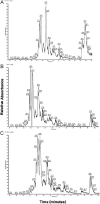Impact of delivery mode of hyaluronan oligomers on elastogenic responses of adult vascular smooth muscle cells
- PMID: 17574666
- PMCID: PMC2041868
- DOI: 10.1016/j.biomaterials.2007.05.019
Impact of delivery mode of hyaluronan oligomers on elastogenic responses of adult vascular smooth muscle cells
Abstract
Our prior studies demonstrated that exogenous supplements of pure hyaluronan (HA) tetramers (HA4) dramatically upregulate elastin matrix synthesis by adult vascular smooth muscle cells (SMCs). Some studies suggest that exogenous HA likely only transiently contacts and signals cells, and may elicit different cell responses when presented on a substrate (e.g., scaffold surface). To clarify such differences, we used a carbodiimide-based chemistry to tether HA4 onto glass, and compared elastin matrix synthesis by SMCs cultured on these substrates, with those cultured with equivalent amounts of exogenous HA4. Tethered HA4-layers were first characterized for homogeneity, topography, and hydrolytic stability using SEM, XPS, AFM, and FACE. In general, mode of HA4 presentation did not influence its impact on SMC proliferation, or cell synthesis of tropoelastin and matrix elastin, relative to non-HA controls; however, surface-tethered HA4 stimulated SMCs to generate significantly greater amounts of elastin-stabilizing desmosine crosslinks, which partially accounts for the greater resistance to enzymatic breakdown of elastin derived from these cultures. Elastin derived from both sets of cultures contained peptide masses that correspond to the predominant peptides present in rat aortic elastin. SEM and TEM showed that HA4-stimulated fibrillin-mediated elastin matrix deposition, and organization into fibrils. Surface-immobilized HA4 was particularly conducive to organization of elastin into aggregating fibrils, and their networking to form closely woven sheets of elastin fibers, as seen in cardiovascular tissues. The results suggest that incorporation of elastogenic HA4 mers onto cell culture substrates or scaffolds is a better approach than exogenous supplementation for in vitro or in vivo regeneration of architecturally and compositionally faithful-, and more stable mimics of native vascular elastin matrices.
Figures





Similar articles
-
Elastogenic effects of exogenous hyaluronan oligosaccharides on vascular smooth muscle cells.Biomaterials. 2006 Nov;27(33):5698-707. doi: 10.1016/j.biomaterials.2006.07.020. Epub 2006 Aug 8. Biomaterials. 2006. PMID: 16899292
-
Fragment size- and dose-specific effects of hyaluronan on matrix synthesis by vascular smooth muscle cells.Biomaterials. 2006 May;27(15):2994-3004. doi: 10.1016/j.biomaterials.2006.01.020. Epub 2006 Feb 2. Biomaterials. 2006. PMID: 16457881
-
Transforming growth factor beta 1 and hyaluronan oligomers synergistically enhance elastin matrix regeneration by vascular smooth muscle cells.Tissue Eng Part A. 2009 Mar;15(3):501-11. doi: 10.1089/ten.tea.2008.0040. Tissue Eng Part A. 2009. PMID: 18847364 Free PMC article.
-
Benefits of concurrent delivery of hyaluronan and IGF-1 cues to regeneration of crosslinked elastin matrices by adult rat vascular cells.J Tissue Eng Regen Med. 2008 Mar-Apr;2(2-3):106-16. doi: 10.1002/term.70. J Tissue Eng Regen Med. 2008. PMID: 18338830
-
Elastic fibers and biomechanics of the aorta: Insights from mouse studies.Matrix Biol. 2020 Jan;85-86:160-172. doi: 10.1016/j.matbio.2019.03.001. Epub 2019 Mar 15. Matrix Biol. 2020. PMID: 30880160 Free PMC article. Review.
Cited by
-
Role of hyaluronan in angiogenesis and its utility to angiogenic tissue engineering.Organogenesis. 2008 Oct;4(4):203-14. doi: 10.4161/org.4.4.6926. Organogenesis. 2008. PMID: 19337400 Free PMC article.
-
Elastogenesis in Focus: Navigating Elastic Fibers Synthesis for Advanced Dermal Biomaterial Formulation.Adv Healthc Mater. 2024 Oct;13(27):e2400484. doi: 10.1002/adhm.202400484. Epub 2024 Jul 11. Adv Healthc Mater. 2024. PMID: 38989717 Free PMC article. Review.
-
Molecular regulation of contractile smooth muscle cell phenotype: implications for vascular tissue engineering.Tissue Eng Part B Rev. 2010 Oct;16(5):467-91. doi: 10.1089/ten.TEB.2009.0630. Tissue Eng Part B Rev. 2010. PMID: 20334504 Free PMC article. Review.
-
Impact of pre-existing elastic matrix on TGFβ1 and HA oligomer-induced regenerative elastin repair by rat aortic smooth muscle cells.J Tissue Eng Regen Med. 2011 Feb;5(2):85-96. doi: 10.1002/term.286. J Tissue Eng Regen Med. 2011. PMID: 20653044 Free PMC article.
-
Nanoparticles for localized delivery of hyaluronan oligomers towards regenerative repair of elastic matrix.Acta Biomater. 2013 Dec;9(12):9292-302. doi: 10.1016/j.actbio.2013.07.032. Epub 2013 Aug 2. Acta Biomater. 2013. PMID: 23917150 Free PMC article.
References
-
- Ross R, Bornstein P. Elastic fibers in the body. Sci Am. 1971;224(6):44–52. - PubMed
-
- Li DY, Brooke B, Davis EC, Mecham RP, Sorensen LK, Boak BB, Eichwald E, Keating MT. Elastin is an essential determinant of arterial morphogenesis. Nature. 1998;393(6682):276–80. - PubMed
-
- Karnik SK, Brooke BS, Bayes-Genis A, Sorensen L, Wythe JD, Schwartz RS, Keating MT, Li DY. A critical role for elastin signaling in vascular morphogenesis and disease. Development. 2003;130(2):411–23. - PubMed
-
- Kimura Y, Okuda H. Inhibitory effects of soluble elastin on intraplatelet free calcium concentration. Thromb Res. 1988;52(1):61–4. - PubMed
-
- Robert L, Jacob MP, Fulop T. Elastin in blood vessels. Ciba Found Symp. 1995;192:286–99. - PubMed
Publication types
MeSH terms
Substances
Grants and funding
LinkOut - more resources
Full Text Sources
Other Literature Sources
Miscellaneous

